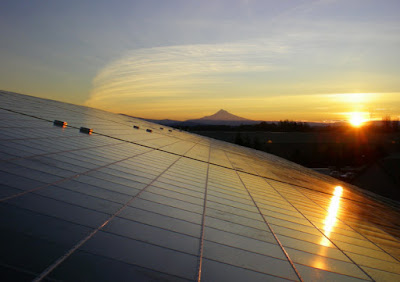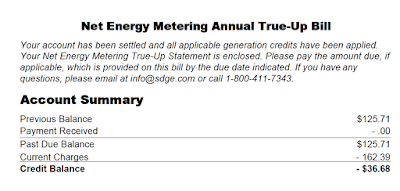We've arrived at zero net cost (-$472 actual) for the energy required to live in our home and drive our two electric BMW i3’s powered by Solar PV.
The utility savings from our Solar PV system installed in 2007 and the gasoline savings from our EV driving beginning in 2009 with the BMW Mini-E, led to our energy plant / Solar PV system being fully paid off in April of 2012. For our family, we have an ongoing savings of around $8000 a year continuing for the next few decades.
But there’s another side of the story to tell, a story of
design scale and the relationship between the car and the source of fuel that's both surprising and fascinating.
Design.
Design.
Good design has a natural scale, for example the scale of an object as compared to a person, such as the height of a ceiling. Or the proximity of an object to another object or person, such as landscaping, that when done well provides a sense of comfortableness, a feeling of beauty. It works well and fits together nicely.
When not done well, a poor design scale can seem awkward, weird, and uninviting. “What the heck were they trying do here” is a typical response resulting from poor design scale.
When not done well, a poor design scale can seem awkward, weird, and uninviting. “What the heck were they trying do here” is a typical response resulting from poor design scale.
Now let’s take a look at the design scale between the car, a
parking space, and the space required to power the car a typical 12,000 miles a year.
An average parking space for a car is 9 ft. by 18 ft. for a
total of 162 ft. An average residential garage space per car is even greater at more than 200 sq. ft.
From our real world "Driving to Net Zero" experience, we know that our car the BMW i3, requires 2860 kWh to drive 12,000
miles. We also know that for each kw
in system size our Solar PV system located in coastal California produced 1588
kWh. For our individual situation, a Solar PV system size of 1.8
kw is required to provide the electricity to drive our BMW i3 12,000 miles a year.
For a better comparison, let’s design an average system size that will work for the majority of electric cars in all areas of the USA.
The efficiency of electric cars range from 3 miles per kWh to 4.2 miles per kWh. Additionally, solar resources vary across the nation. Factoring in the lowest solar resources and a larger EV, a 3 kw Solar PV system size is needed to power the vast majority of eclectic car choices 12,000 miles a year, anywhere in the USA.
 |
| Solar resources across the USA. |
How large is a 3 kw Solar PV system? The SunPower
X21 panel produces 345 watts and is 17.57 sq. feet in size at 61.4inches by
41.2 inches. 8.7 panels are needed for a
3 kw system size but let's call it 9 panels for 3.1 kw system to keep the math
easy for a total of 158 sq. ft.
To recap:
To recap:
A typical parking space for most cars anywhere in
the USA is 162 sq. ft.
A Solar PV system in California, 12,000 miles in a BMW i3 is 92 sq. ft.
A Solar PV system in California, 12,000 miles in a BMW i3 is 92 sq. ft.
A Solar PV system anywhere USA, 12,000 miles in any EV is 158 sq. ft.
That’s a beautiful proportional design scale. The size of the space required to park a car is larger than the space it takes to provide power for the car.
That’s a beautiful proportional design scale. The size of the space required to park a car is larger than the space it takes to provide power for the car.
You're probably thinking to yourself, this will never work, the $9,000 to install the 3 kw Solar PV system for the car over one parking space is too expensive.
Do you ever think about how expensive that parking space is? A paved parking space can run from from $4,000 to $40,000 (source link) each depending on location and we've managed to build 4-5 for each car in our cities. One space at home, one on the curb, one at work, and one or two out in the city for your use as you shop and run errands.
When you add up the multiple parking spaces per car, it's very clear that providing parking for the car is many times more expensive and land intensive, than providing the energy to power the car during a 25-40 year time frame. It cracks me up that we still refer to it as free parking.
 |
| The parking spaces can be more expensive than the Solar PV. |
Relationship.
A relationship can be a coupling, cause and effect, harmony between two or more, the way two or more are connected, a symbiotic reliance on the other.
A relationship can be a coupling, cause and effect, harmony between two or more, the way two or more are connected, a symbiotic reliance on the other.
All cars need an energy relationship to move.
Currently most cars have a required relationship with a gas station. You simply must fuel your car at a gas station. The gas station stores and dispenses the fuel that arrives by tanker truck from the refinery. The refinery receives the crude oil from a tanker or oil pipeline. The oil tanker receives the crude oil from a pipeline or tanker truck that receives it from an oil well or oil source.
Currently most cars have a required relationship with a gas station. You simply must fuel your car at a gas station. The gas station stores and dispenses the fuel that arrives by tanker truck from the refinery. The refinery receives the crude oil from a tanker or oil pipeline. The oil tanker receives the crude oil from a pipeline or tanker truck that receives it from an oil well or oil source.
This conveyance chain of hydrocarbons to your car can be thousands of miles long traversing oceans. In this long carbon chain, you are the payer at the end of the chain with all the owners of the pieces of the chain enriched by your payment.
This long hydrocarbon conveyance chain is also very inefficient, resulting in less than 20% of the
original energy contained in the crude oil reaching the wheels of your car where they meet the
pavement.
The electric car also has a required relationship with
electricity. This can be made from many more sources including Solar PV
that sits on the roof or carport above one of the parking spaces provided for the car. The conveyance chain can be as short as 30 feet, from where the sun shines on the Solar panel to your car.
This electricity harvested from the sunshine supply chain to your car is owned entirely by you. This conveyance chain supplies the electricity to your car where your car is parked and results in over 85% of the original sourced electricity reaching the wheels of your car where they meet the pavement.
This electricity harvested from the sunshine supply chain to your car is owned entirely by you. This conveyance chain supplies the electricity to your car where your car is parked and results in over 85% of the original sourced electricity reaching the wheels of your car where they meet the pavement.
That’s a beautiful relationship between the car, electricity and nature that ultimately enriches you the owner. We can provide the electricity for our cars in this space with Solar PV at a fixed cost equivalent of $0.50 - $0.75 per gallon of gasoline.
Relationships and design...They matter.
 |
| Our BMW Mini-E and our fuel station in 2009. |



































